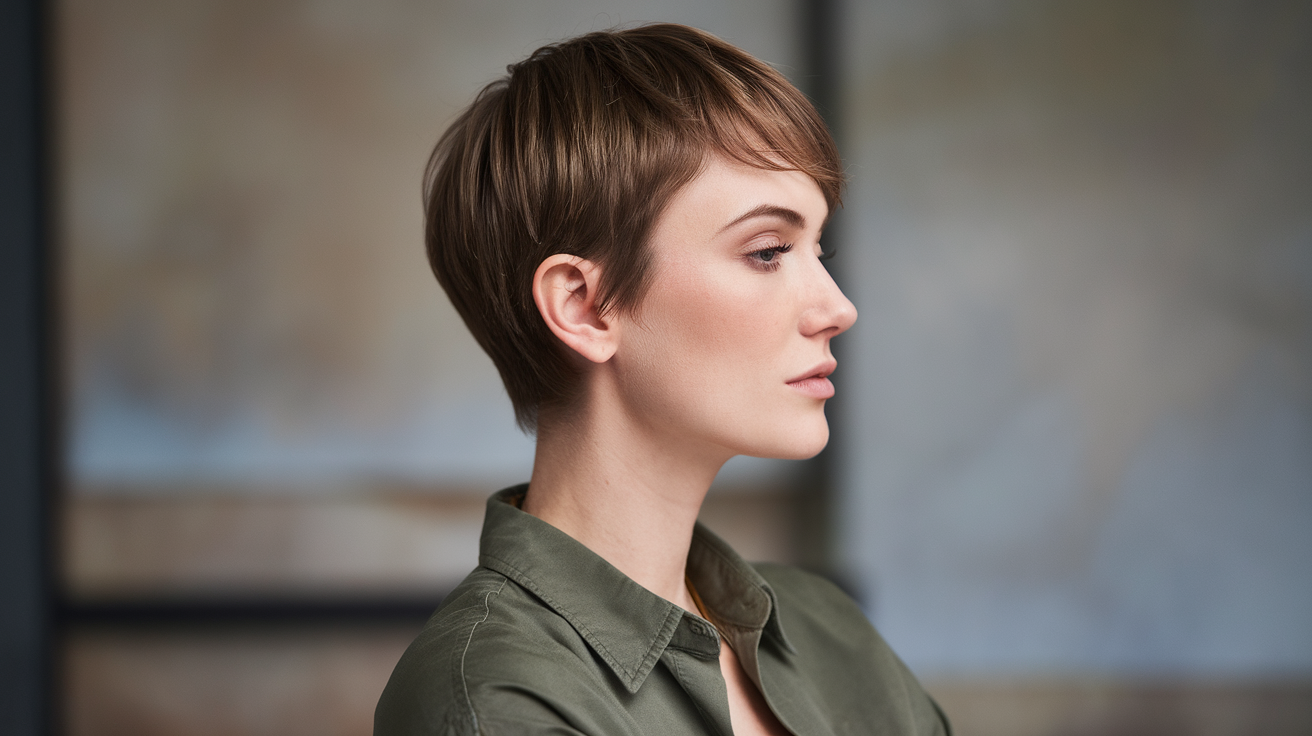Pixie haircuts have become a popular choice for women seeking a bold and low-maintenance style. This short, chic cut typically features closely cropped sides and back, with slightly longer layers on top. Pixie cuts offer versatility, allowing for various styling options despite their short length.
This year, pixie cuts are making waves in the hair fashion world. Their popularity stems from their ability to highlight facial features and provide a fresh, youthful appearance. Many women are opting for this style due to its easy upkeep and the confidence boost it often brings. The pixie cut’s adaptability to different hair textures and face shapes has also contributed to its widespread appeal.
In the following sections, we’ll explore five trendy pixie haircut variations that are gaining traction. From the timeless classic pixie to more daring styles like the undercut pixie, we’ll cover the key features of each look and provide insights on how to style them. Whether you’re considering a dramatic change or simply curious about short hair trends, read on to discover which pixie cut might be perfect for you.
The Classic Pixie: A Timeless Favorite
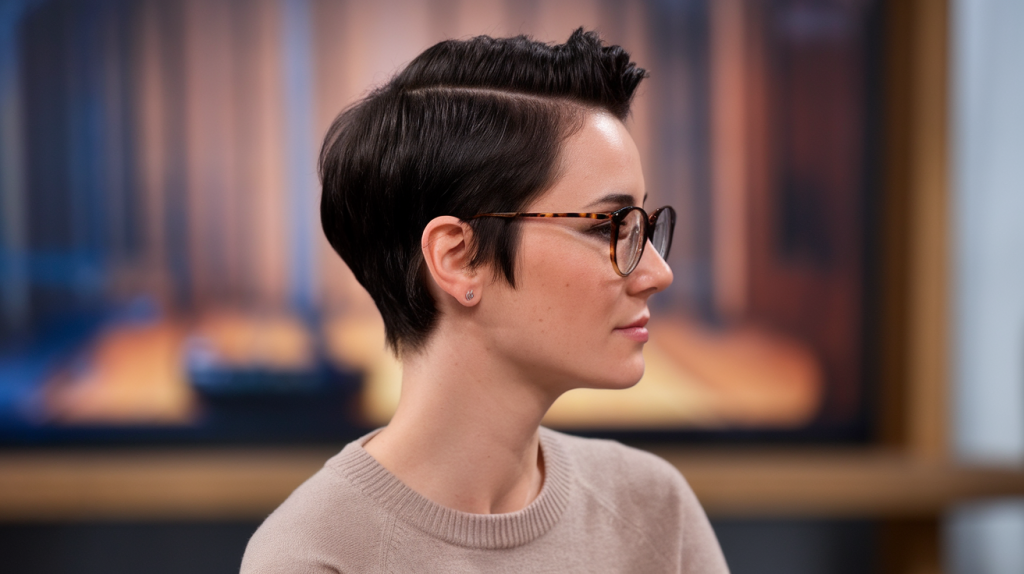
The classic pixie haircut has stood the test of time, remaining a popular choice for women who prefer short, chic styles. This iconic look offers a perfect blend of simplicity and sophistication, making it a go-to option for those seeking a low-maintenance yet stylish hairdo.
Short and sweet: Defining the classic pixie
What exactly is a classic pixie cut? It’s a short hairstyle characterized by closely cropped sides and back, with slightly longer layers on top. The length typically ranges from 1/2 inch to 3 inches, allowing for some versatility in styling. This haircut emphasizes your facial features, particularly your eyes and cheekbones, creating a bold and confident look.
The beauty of the classic pixie lies in its versatility. You can wear it sleek and polished for a professional setting or tousle it for a more casual, effortless vibe. Its adaptability makes it suitable for various occasions and personal styles.
How to achieve the perfect classic pixie
Getting the ideal classic pixie cut requires careful planning and execution. Here are some tips to help you achieve the look you want:
- Bring reference photos to your stylist
- Discuss your face shape and hair texture
- Consider your lifestyle and styling preferences
- Be open to your stylist’s suggestions
- Start longer and gradually go shorter if you’re unsure
Remember, communication with your stylist is key. They can help you customize the cut to flatter your features and suit your personal style.
Styling tips for a polished look
Styling a classic pixie can be quick and easy, perfect for busy mornings. To achieve a polished look, start with damp hair and apply a small amount of mousse or styling cream. Use your fingers or a small brush to direct the hair into place, focusing on creating volume at the crown if desired.
For a sleek finish, you can use a flat iron on the longer top sections. If you prefer a more textured look, try using a small amount of pomade or wax to piece out the ends. Experiment with different products and techniques to find what works best for your hair type and desired style.
Maintenance and upkeep
One of the advantages of a classic pixie cut is its low maintenance nature. However, to keep it looking its best, regular trims are essential. Aim to visit your stylist every 4-6 weeks to maintain the shape and prevent it from growing out unevenly.
Daily care for a pixie cut is straightforward. Wash your hair as needed, using products suitable for your hair type. A gentle shampoo and lightweight conditioner are usually sufficient. If you have fine hair, be cautious not to over-condition, as this can weigh down your style.
Best face shapes for the classic pixie
While the classic pixie can suit many face shapes, it’s particularly flattering for certain features. Oval and heart-shaped faces often look stunning with this cut, as it highlights their balanced proportions. Women with strong cheekbones or delicate facial features can also rock this style beautifully.
If you have a round face, consider a pixie with more length on top to create the illusion of a longer face. For square faces, softer layers around the temples can help balance strong jawlines. Remember, a skilled stylist can always adapt the cut to complement your unique features.
The classic pixie cut offers a timeless elegance that can boost your confidence and simplify your hair care routine. Whether you’re drawn to its low-maintenance appeal or its ability to showcase your facial features, this iconic style continues to captivate women of all ages. With the right cut and styling techniques, you can make the classic pixie your signature look, expressing your personality through this chic and versatile hairstyle.
Textured Pixie: Adding Depth and Dimension
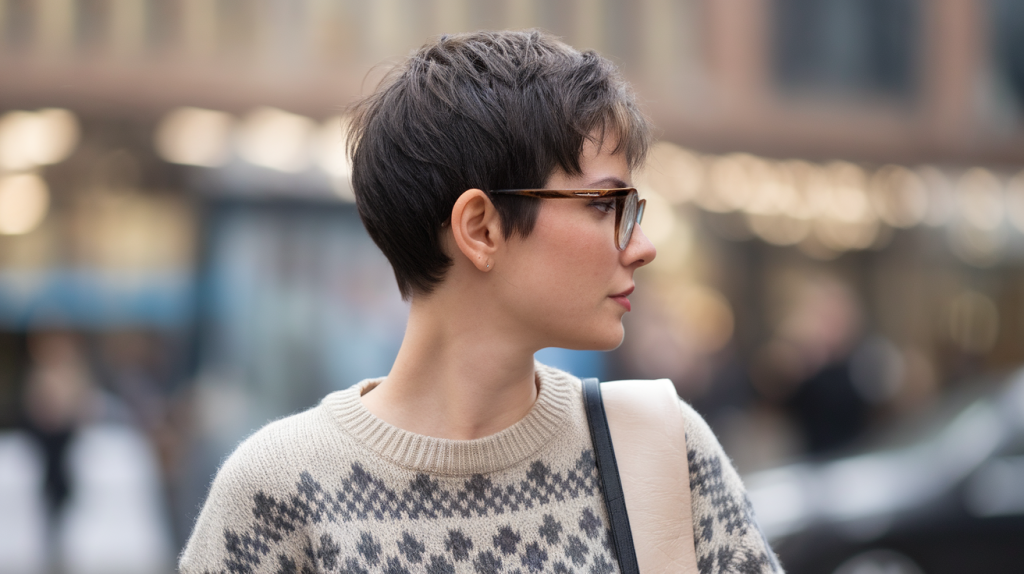
The textured pixie haircut offers a fresh twist on the classic short style, adding movement and personality to your look. This modern variation brings depth and dimension to your hair, creating a more dynamic and versatile appearance.
What sets the textured pixie apart?
A textured pixie differs from its classic counterpart by incorporating varied lengths and choppy layers throughout the cut. This technique creates a more relaxed, effortless vibe that can be easily customized to suit your personal style. The added texture allows for more movement and flexibility in styling, giving you the freedom to switch up your look from day to day.
One of the key benefits of this style is its ability to add volume to fine or thin hair. The varied lengths create the illusion of fuller, thicker locks, making it an excellent choice for women looking to boost their hair’s appearance.
Techniques for creating texture in short hair
Achieving the perfect textured pixie involves several cutting techniques that your stylist can employ:
- Point cutting: This method involves cutting into the hair at an angle to create soft, textured ends
- Razor cutting: Using a razor to slice into the hair, creating wispy, feathered layers
- Texturizing shears: Special scissors that remove bulk and add texture without changing the overall shape
Your stylist might use a combination of these techniques to achieve the desired level of texture. It’s important to communicate your preferences clearly to ensure you get the look you want.
Products to enhance texture
The right products can make a significant difference in enhancing and maintaining the texture of your pixie cut. Here are some essential items to consider adding to your hair care routine:
- Texturizing spray: Adds grit and hold to your hair, perfect for creating that tousled look
- Sea salt spray: Gives your hair a beachy, windswept texture
- Dry shampoo: Absorbs excess oil and adds volume at the roots
- Pomade or wax: Provides definition and hold for individual pieces of hair
- Volumizing mousse: Adds body and lift to fine or thin hair
Experiment with different products to find the combination that works best for your hair type and desired style.
Styling options for different occasions
The versatility of a textured pixie allows you to adapt your look for various settings. For a casual, everyday style, try using your fingers to work a small amount of texturizing product through your hair, creating a tousled, effortless appearance.
When you need a more polished look for work or formal events, use a small round brush and blow dryer to smooth out the top section while maintaining some texture. Finish with a light-hold hairspray to keep everything in place without losing the natural movement.
For a night out, you can amp up the drama by using a flat iron to create more defined pieces and add extra volume at the crown. A bit of pomade or wax can help you create edgy, piece-y looks that stand out.
Ideal hair types for a textured pixie
While a textured pixie can work for many hair types, it’s particularly well-suited for certain textures. Women with naturally wavy or slightly curly hair often find that this cut enhances their natural texture beautifully. The varied lengths allow curls and waves to spring up naturally, creating an effortlessly chic look.
Those with straight hair can also rock this style, though they may need to put in a bit more effort to create and maintain the texture. Using the right products and styling techniques can help straight-haired women achieve that coveted tousled appearance.
For women with very fine hair, a textured pixie can be a game-changer. The layered cutting technique adds volume and the appearance of thicker hair, while the shorter length prevents fine strands from looking limp or weighed down.
If you have thick or coarse hair, a textured pixie can help manage your hair’s volume. The varied lengths and texturizing techniques can remove bulk where needed, making your hair more manageable while still maintaining its natural body.
Choosing a textured pixie cut opens up a world of styling possibilities. This versatile haircut allows you to express your personality through your hair, whether you prefer a sleek, professional look or a more edgy, tousled style. With the right cut, products, and styling techniques, you can make this trendy short hairstyle work for you, regardless of your hair type or lifestyle.
Asymmetrical Pixie: Edgy and Bold

The asymmetrical pixie cut is a bold choice for women who want to make a statement with their hair. This edgy style combines the short, low-maintenance appeal of a traditional pixie with an uneven, artistic flair that turns heads and sparks conversations.
What makes a pixie asymmetrical?
An asymmetrical pixie is characterized by intentionally uneven lengths across the head. Typically, one side is noticeably longer than the other, creating a dynamic and eye-catching silhouette. This imbalance can be subtle or dramatic, depending on your preference and comfort level.
The longer side often falls somewhere between the cheekbone and jawline, while the shorter side is cropped close to the head. This contrast in length adds depth and dimension to the overall look, making it a versatile option for various face shapes and hair textures.
How to communicate your desired asymmetrical cut
When discussing this style with your stylist, clear communication is key. Here are some tips to help you express your vision:
- Bring visual references: Photos of asymmetrical pixies you like can help your stylist understand your goals
- Specify the length difference: Indicate how much longer you want one side compared to the other
- Discuss face-framing: Decide if you want longer pieces around your face on the longer side
- Consider your lifestyle: Talk about your daily routine to ensure the cut suits your needs
Remember, your stylist is there to help you achieve the look you want while considering what works best for your hair type and face shape.
Styling techniques for an asymmetrical pixie
Styling an asymmetrical pixie can be fun and creative. The key is to emphasize the intentional unevenness of the cut. Start by applying a volumizing mousse to damp hair, focusing on the roots. Use a blow dryer with a concentrator nozzle to direct the hair on the longer side towards your face, creating a sweeping effect.
For a sleek look, use a flat iron to smooth out any kinks or waves. If you prefer a more textured appearance, try scrunching in a sea salt spray and letting your hair air dry. To add extra volume and definition to the longer side, use a small round brush while blow-drying.
Complementary makeup looks
Your makeup can enhance the edgy vibe of your asymmetrical pixie. Bold eye makeup works well with this daring hairstyle. Try a smoky eye or a winged eyeliner to draw attention to your eyes and balance the asymmetry of your hair.
For a softer look, focus on creating glowing skin with a dewy foundation and highlighter on your cheekbones. A bold lip color can also complement this hairstyle beautifully, adding another element of confidence to your overall appearance.
Confidence tips for rocking this daring style
Wearing an asymmetrical pixie requires a certain level of self-assurance. Here are some tips to help you feel confident with your new look:
- Own your choice: Remember that you chose this style because you liked it
- Practice positive self-talk: Remind yourself daily how great you look
- Experiment with accessories: Try headbands or statement earrings to accentuate your cut
- Dress the part: Wear clothes that make you feel powerful and complement your new style
- Be prepared for comments: Have a ready response for people who ask about your hair
An asymmetrical pixie is more than just a haircut – it’s a statement of individuality and confidence. By choosing this style, you’re showing the world that you’re not afraid to stand out and express yourself through your appearance.
Maintaining an asymmetrical pixie requires regular trims to keep the shape intact. Schedule appointments with your stylist every 4-6 weeks to maintain the distinct lengths and overall shape of your cut. This will help you keep your style looking fresh and intentional.
As you become more comfortable with your asymmetrical pixie, don’t be afraid to play with different styling products and techniques. You might discover new ways to wear your hair that you hadn’t considered before. The versatility of this cut allows for a range of looks, from sleek and professional to edgy and avant-garde.
Undercut Pixie: Daring and Versatile
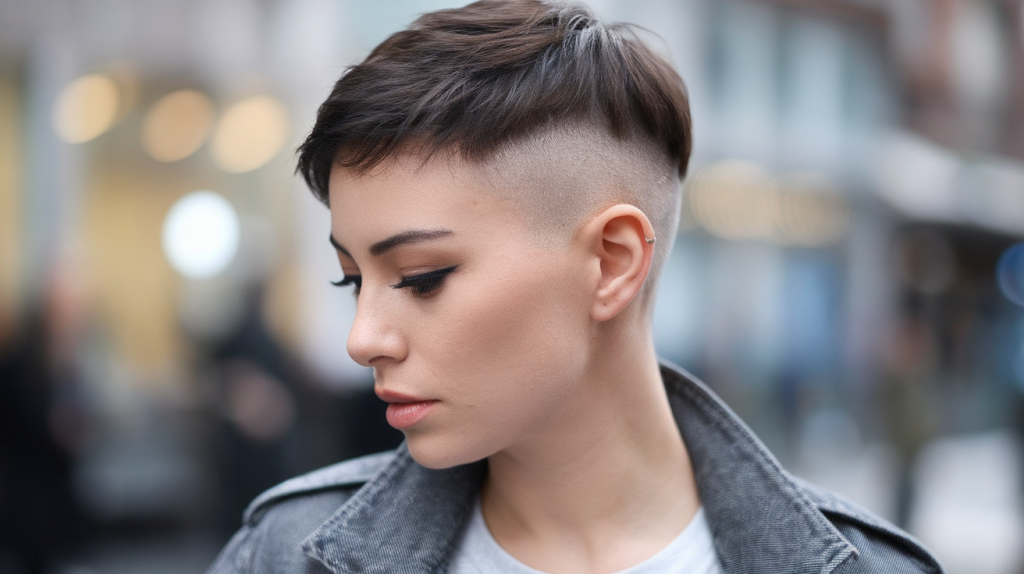
The undercut pixie is a bold and edgy hairstyle that combines the short, chic look of a traditional pixie with the daring flair of an undercut. This style offers a perfect blend of femininity and rebellion, allowing you to express your personality through your hair.
What is an undercut pixie?
An undercut pixie features longer hair on top, typically styled in a pixie cut, while the sides and back are shaved or cut very short. This creates a striking contrast between the longer top section and the closely cropped lower portions. The result is a hairstyle that’s both versatile and attention-grabbing.
The beauty of this style lies in its adaptability. You can choose to reveal or conceal the undercut depending on how you style the longer top section. This flexibility makes it an excellent choice for women who want to experiment with a bold look while maintaining the option to sport a more conventional appearance when needed.
Customizing your undercut: patterns and designs
One of the most exciting aspects of an undercut pixie is the opportunity to add personal touches through patterns and designs. The shaved portion of your hair becomes a canvas for creative expression. Here are some popular options:
- Geometric shapes: Lines, triangles, or diamonds
- Floral patterns: Delicate flowers or leaves
- Abstract designs: Swirls, waves, or asymmetrical patterns
- Words or symbols: Short phrases or meaningful icons
Your stylist can help you choose a design that complements your face shape and personal style. Keep in mind that intricate designs may require more frequent touch-ups to maintain their crisp appearance.
Growing out an undercut pixie
If you decide to grow out your undercut pixie, patience is key. The process can take several months, but there are ways to make the transition smoother:
- Start by letting the undercut grow for a few weeks without trimming.
- As it grows, blend the longer top section with the growing undercut using texturizing techniques.
- Consider using bobby pins or hair accessories to style the awkward-length sections creatively.
- Regular trims of the top section can help maintain a balanced look during the growing-out phase.
- Experiment with different styling products to manage any unruly growth.
Remember, the growing-out process is temporary, and with some creativity, you can find stylish ways to wear your hair at each stage.
Styling options for various occasions
The versatility of an undercut pixie allows for numerous styling options suitable for different events and settings. For a professional look, you might smooth the longer top section over the undercut, creating a sleek appearance. This can be achieved using a flat iron and some smoothing serum.
For a more casual, edgy look, try styling the top section upwards and to the side, revealing the undercut. A texturizing spray can help add volume and hold to this style. If you’re heading to a formal event, consider using gel or pomade to create a sleek, swept-back look that showcases the contrast between the longer and shorter sections.
Hair accessories to enhance the look
Hair accessories can add an extra dimension to your undercut pixie, allowing you to change up your style quickly and easily. Consider these options to elevate your look:
- Headbands: Wide or thin, plain or embellished
- Hair clips: Decorative barrettes or minimalist metal clips
- Scarves: Tied as headbands or wrapped around the head
- Temporary color sprays: For adding pops of color to the undercut area
- Fascinators or small hats: For formal occasions
These accessories can help you transition your undercut pixie from day to night, casual to formal, with minimal effort.
Maintaining an undercut pixie requires regular upkeep to keep it looking sharp. Plan for visits to your stylist every 3-4 weeks to trim the undercut and shape the longer top section. This will help maintain the distinct contrast that defines this style.
As you become more comfortable with your undercut pixie, don’t hesitate to experiment with different styling techniques and products. You might discover new ways to wear your hair that you hadn’t considered before. The key is to have fun with your style and let it reflect your personality.
Pixie with Long Bangs: The Best of Both Worlds
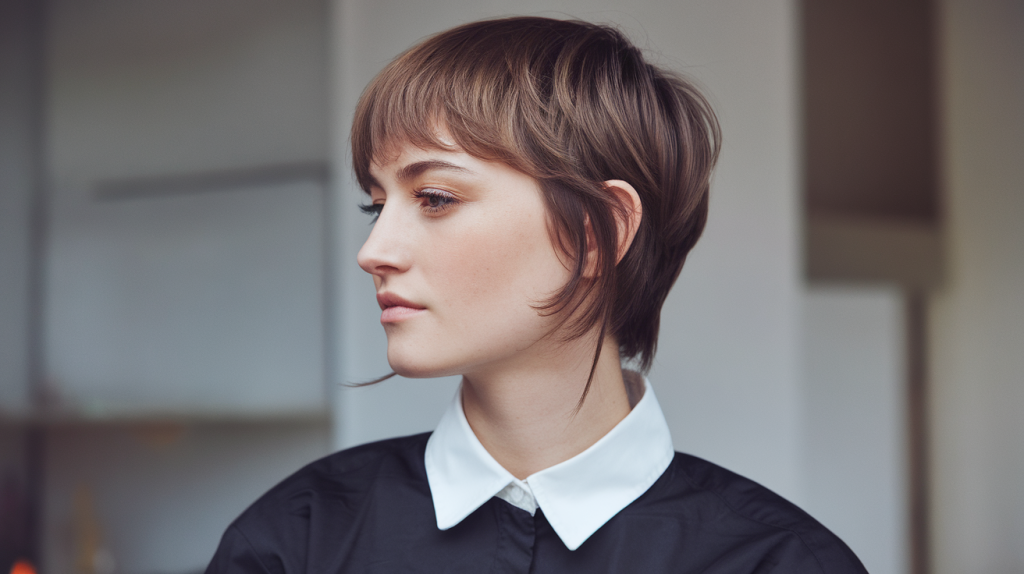
A pixie cut with long bangs offers a perfect blend of short hair convenience and the versatility of longer strands. This style combines the low-maintenance appeal of a classic pixie with the softness and face-framing benefits of longer bangs. Let’s explore how you can make this trendy look work for you.
How long should the bangs be?
The ideal length for your bangs depends on your face shape and personal preference. Generally, pixie bangs range from eyebrow-skimming to chin-length. Shorter bangs can create a more youthful appearance, while longer bangs offer more styling flexibility.
For round faces, try bangs that hit at the cheekbones to elongate your face. If you have a square face, opt for side-swept bangs that soften your jawline. Oval faces can pull off almost any length, so feel free to experiment!
Styling options for pixie bangs
Long bangs on a pixie cut open up a world of styling possibilities. Here are some popular ways to wear your bangs:
- Side-swept: Brush your bangs to one side for a classic, elegant look
- Straight and sleek: Use a flat iron for a polished appearance
- Textured and piece-y: Apply a texturizing spray for an effortless, tousled vibe
- Pinned back: Use bobby pins to create different looks, like a faux pompadour
- Braided: Try a small braid along your hairline for a bohemian touch
Experiment with these styles to find what works best for your face shape and personal style.
Trimming and maintaining long bangs
Regular trims are crucial for keeping your long pixie bangs looking their best. Aim to trim them every 2-3 weeks to maintain their shape and prevent them from obstructing your vision. You can do this at home with sharp hair scissors, but if you’re unsure, it’s best to visit your stylist.
To trim your bangs at home:
- Start with dry, styled hair to see how they naturally fall
- Section off your bangs from the rest of your hair
- Hold the scissors vertically and make small snips into the ends
- Avoid cutting straight across, as this can result in a blunt, harsh line
- Check the length frequently and adjust as needed
Remember, it’s always better to cut less than you think you need – you can always trim more, but you can’t put hair back!
Face-framing techniques
Long bangs offer excellent opportunities for face-framing, which can enhance your best features and soften any areas you’d like to downplay. Your stylist can create layers within your bangs to complement your face shape.
For heart-shaped faces, ask for longer pieces around the cheekbones to balance a narrower chin. If you have a long face, consider curtain bangs that part in the middle and sweep to either side, creating the illusion of width.
Don’t be afraid to play with different parting styles. A deep side part can add drama and volume, while a center part can create a more symmetrical look.
Transitioning from a traditional pixie to one with long bangs
If you’re growing out a traditional pixie into one with longer bangs, patience is key. The transition period can be challenging, but there are ways to make it easier:
- Use hair accessories: Headbands, clips, and pins can help manage awkward-length hair
- Try new styling products: Texturizing sprays and pomades can give you more control over shorter pieces
- Get regular trims: This helps maintain the overall shape as your bangs grow
- Experiment with different parts: Changing your part can help disguise uneven growth
- Consider temporary extensions: These can help you achieve the look of long bangs while your hair grows
As your bangs grow, you’ll have more styling options. Take this time to experiment with different looks and find what suits you best.
Maintaining a pixie with long bangs requires a bit more effort than a traditional pixie, but the payoff in versatility is worth it. Invest in quality styling products that work for your hair type. A good texturizing spray, smoothing serum, and dry shampoo can be game-changers for this style.
Don’t forget to protect your hair from heat damage if you frequently use styling tools. Apply a heat protectant before using flat irons or curling wands, and try to embrace your natural texture when possible. With the right care and styling, your pixie with long bangs can be a chic, adaptable look that suits a variety of occasions and personal styles.
Pixie Perfection: Your Path to Chic, Confident Style
The world of pixie cuts offers a diverse range of options for women seeking a bold, low-maintenance hairstyle. From the classic pixie to edgier variations like the asymmetrical and undercut styles, there’s a pixie cut to suit every face shape, hair texture, and personal style. These versatile cuts allow you to express your individuality while enjoying the convenience of short hair.
As you consider which pixie style might work best for you, remember that the key to rocking any short haircut is confidence. Whether you opt for a textured pixie with added depth, an asymmetrical cut that turns heads, or a pixie with long bangs for extra versatility, your attitude is what truly makes the style shine. Don’t be afraid to experiment with different styling techniques, products, and accessories to make your pixie uniquely yours. With the right cut and a bit of creativity, you’ll find that a pixie haircut can be both liberating and empowering, opening up a world of style possibilities.
Frequently Asked Questions
Q: What is a pixie haircut?
A: A pixie haircut is a short hairstyle characterized by closely cropped sides and back, with slightly longer layers on top. The length typically ranges from 1/2 inch to 3 inches.
Q: How often should I trim my pixie cut?
A: For most pixie cuts, it’s recommended to get a trim every 4-6 weeks to maintain the shape and prevent uneven growth.
Q: What is an asymmetrical pixie cut?
A: An asymmetrical pixie cut features intentionally uneven lengths across the head, with one side noticeably longer than the other, typically falling between the cheekbone and jawline.
Q: How do I style a textured pixie cut?
A: To style a textured pixie, apply a volumizing mousse to damp hair, focusing on the roots. Use a blow dryer with a concentrator nozzle to create volume and texture, and finish with a texturizing spray for added definition.
Q: What is an undercut pixie?
A: An undercut pixie features longer hair on top styled in a pixie cut, while the sides and back are shaved or cut very short, creating a striking contrast.
Q: How do I grow out an undercut pixie?
A: To grow out an undercut pixie, let the undercut grow for a few weeks without trimming, then gradually blend the longer top section with the growing undercut using texturizing techniques. Use bobby pins or hair accessories to style awkward-length sections creatively.
Q: What face shapes work best with a pixie cut with long bangs?
A: Pixie cuts with long bangs can suit various face shapes. For round faces, try bangs that hit at the cheekbones. Square faces benefit from side-swept bangs, while oval faces can pull off almost any length.
Q: How do I maintain long bangs on a pixie cut?
A: Trim long bangs every 2-3 weeks to maintain their shape. When trimming at home, start with dry, styled hair, section off your bangs, and make small vertical snips into the ends, avoiding cutting straight across.

